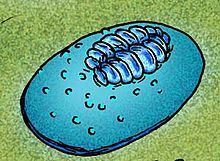Kingdom Animalia Phylum Proarticulata | Genus Onega Rank Species | |
 | ||
Similar Tamga, Lossinia, Solza margarita, Vaveliksia, Windermeria | ||
the evolution of life onega stepanovi
Onega stepanovi is a fossil organism from Ediacaran deposites of the Arkhangelsk Region, Russia. It was described by Mikhail A. Fedonkin in 1976
Contents
Etymology
The generic name Onega comes from the Onega Peninsula of the White Sea, where the first fossils were found. The specific name is given in honour of V. A. Stepanov, discoverer of the first Ediacaran fossil locality in Arkhangelsk Region, on the Letniy Bereg (Summer Coast) of the Onega Peninsula in 1972.
Morphology
The small fossils, which range up to 7 millimetres (0.28 in) long, have oval outlines and low bodies with an articulated central zone built of isomers encircled by an undivided zone. The surface of the undivided region of Onega is covered with small tubercles.
Onega was originally described by Mikhail Fedonkin as a problematic organism, being grouped together with Vendia, Praecambridium and Vendomia as possible stem-group arthropods due to a vague similarity with primitive Cambrian trilobites and arthropods.
In 1985 Mikhail Fedonkin erected Phylum Proarticulata, in which he placed: Onega, Dickinsonia, Palaeoplatoda, Vendia, Vendomia, Praecambridium and Pseudovendia sp., although he did not exclude the possibility that Onega may still be related to various lower Cambrian arthropods, such as Skania.
Andrey Yu. Ivantsov has proposed that Onega be placed in phylum Proarticulata, as the segments in recently discovered, exceptionally well-preserved fossils display the glide, or "staggered", symmetry characteristic of the majority of proarticulatans.
Fossil record
Imprints of Onega stepanovi have been found in the Verkhovka and Zimnie Gory Formations of the Ediacaran (Vendian) rocks of the Arkhangelsk Region, Russia.
All the fossil specimens are negative imprints on the bases of fine-grained sandstone beds with the "elephant skin" and tubercle texture diagnostic of microbial mats. The same bedding planes contain various other Ediacaran species: Cyclomedusa, Ediacaria, palaeopascichnids, Eoporpita, Yorgia, Andiva, Archaeaspinus, Vendia, Dickinsonia, Anfesta, Albumares, Tribrachidium, Kimberella, Parvancorina, Charniodiscus and others.
